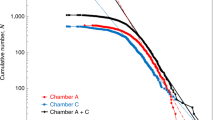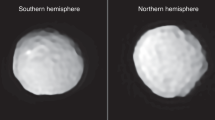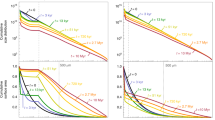Abstract
Establishing the abundance and physical properties of regolith and boulders on asteroids is crucial for understanding the formation and degradation mechanisms at work on their surfaces. Using images and thermal data from NASA’s Origins, Spectral Interpretation, Resource Identification, and Security-Regolith Explorer (OSIRIS-REx) spacecraft, we show that asteroid (101955) Bennu’s surface is globally rough, dense with boulders, and low in albedo. The number of boulders is surprising given Bennu’s moderate thermal inertia, suggesting that simple models linking thermal inertia to particle size do not adequately capture the complexity relating these properties. At the same time, we find evidence for a wide range of particle sizes with distinct albedo characteristics. Our findings imply that ages of Bennu’s surface particles span from the disruption of the asteroid’s parent body (boulders) to recent in situ production (micrometre-scale particles).
This is a preview of subscription content, access via your institution
Access options
Access Nature and 54 other Nature Portfolio journals
Get Nature+, our best-value online-access subscription
$29.99 / 30 days
cancel any time
Subscribe to this journal
Receive 12 digital issues and online access to articles
$119.00 per year
only $9.92 per issue
Buy this article
- Purchase on Springer Link
- Instant access to full article PDF
Prices may be subject to local taxes which are calculated during checkout






Similar content being viewed by others
Code availability
The thermophysical analysis reported here uses a custom code that is based on the Advanced Thermophysical Model (ATPM) of refs. 46,59,60. The ISIS3 code used to generate the image processing data products is available from the US Geological Survey–Astrogeology Science Center: https://isis.astrogeology.usgs.gov/
Data availability
The data that support the plots within this paper and other findings of this study are available from the corresponding authors upon reasonable request. Raw (L0) through calibrated (L2, L3) OCAMS, OVIRS and OTES data will be available via the Planetary Data System (PDS) (https://sbn.psi.edu/pds/resource/orex/). Data are released to the PDS according to the schedule provided in the OSIRIS-REx Data Management Plan found in the OSIRIS-REx PDS archive. Image mosaics and photometric models will be available in the PDS 1 year after departure from the asteroid.
References
Lauretta, D. S. et al. The OSIRIS-REx target asteroid (101955) Bennu: constraints on its physical, geological, and dynamical nature from astronomical observations. Meteorit. Planet. Sci. 50, 834–849 (2015).
Rizk, B. et al. OCAMS: the OSIRIS-REx camera suite. Space Sci. Rev. 214, 26 (2018).
Barnouin, O. S. et al. Shape of (101955) Bennu indicative of a rubble pile with internal stiffness. Nat. Geosci. https://doi.org/10.1038/s41561-019-0330-x(2019).
Reuter, D. C. et al. The OSIRIS-REx visible and infrared spectrometer (OVIRS): spectral maps of the asteroid Bennu. Space Sci. Rev. 214, 54 (2018).
Christensen, P. R. et al. The OSIRIS-REx thermal emission spectrometer (OTES) instrument. Space Sci. Rev. 214, 87 (2018).
Li, J.-Y., Helfenstein, P., Buratti, B., Takir, D. & Clark, B. E. in Asteroids IV (eds Michel, P., DeMeo, F. E. & Bottke, W. F.) 277–326 (Univ. of Arizona Press, Tucson, 2015).
Hergenrother, C. W. et al. Lightcurve, color and phase function photometry of the OSIRIS-REx target asteroid (101955) Bennu. Icarus 226, 663–670 (2013).
Alí-Lagoa, V. et al. Differences between the Pallas collisional family and similarly sized B-type asteroids. Astron. Astrophys. 591, A14 (2016).
Hergenrother, C. W. et al. Operational environment and rotational acceleration of asteroid (101955) Bennu from OSIRIS-REx observations. Nat. Commun. https://doi.org/10.1038/s41467-019-09213-x (2019).
Clark, B. E. et al. Asteroid (101955) 1999 RQ36: spectroscopy from 0.4 to 2.4μm and meteorite analogs. Icarus 216, 462–475 (2011).
Hamilton, V. E. et al. Evidence for widespread hydrated minerals on asteroid (101955) Bennu. Nat. Astron. https://doi.org/10.1038/s41550-019-0722-2 (2019).
Emery, J. P. et al. Thermal infrared observations and thermophysical characterization of OSIRIS-REx target asteroid (101955) Bennu. Icarus 234, 17–35 (2014).
Gundlach, B. & Blum, J. A new method to determine the grain size of planetary regolith. Icarus 223, 479–492 (2013).
Delbo’, M., Mueller, M., Emery, J. P., Rozitis, B. & Capria, M. T. in Asteroids IV (eds Michel, P., DeMeo, F. E. & Bottke, W. F.) 107–128 (Univ. of Arizona Press, Tucson, 2015).
Jakosky, B. M. On the thermal properties of Martian fines. Icarus 66, 117–124 (1986).
Opeil, C. P., Consolmagno, G. J. & Britt, D. T. The thermal conductivity of meteorites: new measurements and analysis. Icarus 208, 449–454 (2010).
Walsh, K. J. Rubble pile asteroids. Annu. Rev. Astron. Astrophys. 56, 593–624 (2018).
Walsh, K. J. et al. Craters, boulders and regolith of (101955) Bennu indicative of an old and dynamic surface. Nat. Geosci. https://doi.org/10.1038/s41561-019-0326-6(2019).
Lauretta, D. S. et al. The unexpected surface of asteroid (101955) Bennu. Natur e https://doi.org/10.1038/s41586-019-1033-6 (2019).
Nolan, M. C. et al. Shape model and surface properties of the OSIRIS-REx target Asteroid (101955) Bennu from radar and lightcurve observations. Icarus 226, 629–640 (2013).
Mazrouei, S., Daly, M. G., Barnouin, O. S., Ernst, C. M. & DeSouza, I. Block distributions on Itokawa. Icarus 229, 181–189 (2014).
Michikami, T. et al. Size-frequency statistics of boulders on global surface of asteroid 25143 Itokawa. Earth Planets Space 60, 13–20 (2008).
Scheeres, D. J. et al. The dynamic geophysical environment of (101955) Bennu based on OSIRIS-REx measurements. Nat. Astron. https://doi.org/10.1038/s41550-019-0721-3 (2019).
Lee, P. et al. Ejecta blocks on 243 Ida and on other asteroids. Icarus 120, 87–105 (1996).
Michel, P., Benz, W., Tanga, P. & Richardson, D. C. Collisions and gravitational reaccumulation: forming asteroid families and satellites. Science 294, 1696–1700 (2001).
Delbo’, M. et al. Thermal fatigue as the origin of regolith on small asteroids. Nature 508, 233–236 (2014).
Opeil, C. P., Consolmagno, G. J., Safarik, D. J. & Britt, D. T. Stony meteorite thermal properties and their relationship with meteorite chemical and physical states. Meteorit. Planet. Sci. 47, 319–329 (2012).
Müller, T. G., Sekiguchi, T., Kaasalainen, M., Abe, M. & Hasegawa, S. Thermal infrared observations of the Hayabusa spacecraft target asteroid 25143 Itokawa. Astron. Astrophys. 443, 347–355 (2005).
Rodgers, D. J., Ernst, C. M., Barnouin, O. S., Murchie, S. L. & Chabot, N. L. Methodology for finding and evaluating safe landing sites on small bodies. Planet. Space Sci. 134, 71–81 (2016).
Müller, T. G. et al. Hayabusa-2 mission target asteroid 162173 Ryugu (1999 JU 3): searching for the object’s spin-axis orientation. Astron. Astrophys. 599, A103 (2017).
Sugita, S. et al. The geomorphology, color, and thermal properties of Ryugu: implications for parent-body processes. Science https://doi.org/10.1126/science.aaw0422 (in the press).
Saito, J. et al. Detailed Images of asteroid 25143 Itokawa from Hayabusa. Science 312, 1341–1344 (2006).
Murchie, S. et al. Color variations on Eros from NEAR multispectral imaging. Icarus 155, 145–168 (2002).
Riner, M. A., Robinson, M. S., Eckart, J. M. & Desch, S. J. Global survey of color variations on 433 Eros: implications for regolith processes and asteroid environments. Icarus 198, 67–76 (2008).
Lantz, C., Binzel, R. P. & DeMeo, F. E. Space weathering trends on carbonaceous asteroids: a possible explanation for Bennu’s blue slope? Icarus 302, 10–17 (2018).
Thompson, M. S., Loeffler, M. J., Morris, R. V., Keller, L. P. & Christoffersen, R. Spectral and chemical effects of simulated space weathering of the Murchison CM2 carbonaceous chondrite. Icarus 319, 499–511 (2019).
Johnson, T. V. & Fanale, F. P. Optical properties of carbonaceous chondrites and their relationship to asteroids. J. Geophys. Res. 78, 8507–8518 (1973).
Sanchez, J. A. et al. Phase reddening on near-Earth asteroids: implications for mineralogical analysis, space weathering and taxonomic classification. Icarus 220, 36–50 (2012).
Li, J. et al. Spectrophotometric modeling and mapping of Ceres. Icarus 322, 144–167 (2019).
Muinonen, K. et al. Asteroid photometric and polarimetric phase curves: joint linear-exponential modeling. Meteorit. Planet. Sci. 44, 1937–1946 (2009).
Pilorget, C., Fernando, J., Ehlmann, B. L., Schmidt, F. & Hiroi, T. Wavelength dependence of scattering properties in the VIS-NIR and links with grain-scale physical and compositional properties. Icarus 267, 296–314 (2016).
Rozitis, B. The surface roughness of (433) Eros as measured by thermal-infrared beaming. Mon. Not. R. Astron. Soc. 464, 915–923 (2017).
Rozitis, B., Green, S. F., MacLennan, E. & Emery, J. P. Observing the variation of asteroid thermal inertia with heliocentric distance. Mon. Not. R. Astron. Soc. 477, 1782–1802 (2018).
Rozitis, B. & Green, S. F. Physical characterisation of near-Earth asteroid (1620) Geographos. Astron. Astrophys. 568, A43 (2014).
Spencer, J. R. A rough-surface thermophysical model for airless planets. Icarus 83, 27–38 (1990).
Rozitis, B. & Green, S. F. Directional characteristics of thermal-infrared beaming from atmosphereless planetary surfaces—a new thermophysical model. Mon. Not. R. Astron. Soc. 415, 2042–2062 (2011).
Jaumann, R. et al. Surface geomorphology of near earth asteroid (162173) Ryugu from in-situ observations: first results from the MASCOT camera. In Am. Geophys. Union Fall Meet. 2018 abstr. P21A-03 (American Geophysical Union, 2018).
Nakamura, A. M., Fujiwara, A. & Kadono, T. Velocity of finer fragments from impact. Planet. Space Sci. 42, 1043–1052 (1994).
Hanuš, J., Delbo’, M., Ďurech, J. & Alí-Lagoa, V. Thermophysical modeling of main-belt asteroids from WISE thermal data. Icarus 309, 297–337 (2018).
Nagao, K. et al. Irradiation history of Itokawa regolith material deduced from noble gases in the Hayabusa samples. Science 333, 1128–1131 (2011).
Scheeres, D. J., Hartzell, C. M., Sánchez, P. & Swift, M. Scaling forces to asteroid surfaces: the role of cohesion. Icarus 210, 968–984 (2010).
Lauretta, D. S. et al. OSIRIS-REx: sample return from asteroid (101955) Bennu. Space Sci. Rev. 212, 925–984 (2017).
Kieffer, H. H. & Stone, T. C. The spectral irradiance of the Moon. Astron. J. 129, 2887–2901 (2005).
McEwen, A. S. A precise lunar photometric function. Lunar Planet. Sci. 27, 841–842 (1996).
DellaGiustina, D. N. et al. Overcoming the challenges associated with image-based mapping of small bodies in preparation for the OSIRIS-REx mission to (101955) Bennu. Earth Space Sci. 5, 929–949 (2018).
Uni-, W. et al. Standard techniques for presentation and analysis of crater size-frequency data. Icarus 37, 467–474 (1979).
Clauset, A., Shalizi, C. R. & Newman, M. E. J. Power-law distributions in empirical data. SIAM Rev. 51, 661–703 (2009).
DeSouza, I., Daly, M. G., Barnouin, O. S., Ernst, C. M. & Bierhaus, E. B. Improved techniques for size-frequency distribution analysis in the planetary sciences: application to blocks on 25143 Itokawa. Icarus 247, 77–80 (2015).
Rozitis, B. & Green, S. F. The influence of rough surface thermal-infrared beaming on the Yarkovsky and YORP effects. Mon. Not. R. Astron. Soc. 423, 367–388 (2012).
Rozitis, B. & Green, S. F. The influence of global self-heating on the Yarkovsky and YORP effects. Mon. Not. R. Astron. Soc. 433, 603–621 (2013).
Gundlach, B. & Blum, J. Outgassing of icy bodies in the Solar System—II: Heat transport in dry, porous surface dust layers. Icarus 219, 618–629 (2012).
Sakatani, N. et al. Thermal conductivity model for powdered materials under vacuum based on experimental studies. AIP Adv. 7, 015310 (2017).
Sakatani, N., Ogawa, K., Arakawa, M. & Tanaka, S. Thermal conductivity of lunar regolith simulant JSC-1A under vacuum. Icarus 309, 13–24 (2018).
Ryan, A. J. Heat and Mass Transfer on Planetary Surfaces PhD thesis, Arizona State Univ. (2018).
Acton, C., Bachman, N., Semenov, B. & Wright, E. A look towards the future in the handling of space science mission geometry. Planet. Space Sci. 150, 9–12 (2018).
Gault, B. D. E., Shoemaker, E. M. & Moore, H. J. Spray Ejected From The Lunar Surface By Meteoroid Impact (NASA, 1963).
Moore, H. J. in Analysis of Apollo 10: Photography and Visual Observations 24–26 (NASA, 1971).
Bart, G. D. & Melosh, H. J. Using lunar boulders to distinguish primary from distant secondary impact craters. Geophys. Res. Lett. 34, L07203 (2007).
Acknowledgements
This material is based upon work supported by NASA under contract NNM10AA11C issued through the New Frontiers Program. We thank C. Ernst for providing the data used in Supplementary Fig. 4 to compare the size-frequency distribution of boulders on Bennu to other small bodies. B.R. acknowledges funding support from the Royal Astronomical Society in the form of a research fellowship. P.M. acknowledges funding support from the French space agency CNES and from Academies of Excellence: Complex systems and Space, environment, risk, and resilience, part of the IDEX JEDI of the Université Côte d’Azur. M.A.B., J.D.P.D. and S.F. also acknowledge financial support from CNES the French space agency. M.P. acknowledges funding support from the Italian Space Agency (ASI) under the ASI-INAF agreement no. 2017–37-H.0. Part of this work was performed at the Jet Propulsion Laboratory, California Institute of Technology under contract with the National Aeronautics and Space Administration. S.R.S. acknowledges support from NASA Grant no. 80NSSC18K0226 as part of the OSIRIS-REx Participating Scientist Program.
Author information
Authors and Affiliations
Consortia
Contributions
D.N.D. leads the OSIRIS-REx Image Processing Working Group (IPWG). J.P.E. leads the OSIRIS-REx Thermal Analysis Working Group (TAWG). Both led the analysis and paper writing efforts. M.A.B., C.A.B., K.N.B., H.C., J.d.L., C.Y.D.d’A., S.F., D.R.G., C.H., E.S.H., H.H.K., T.K., L.L.C., J.-Y.L., J.L., J.L.R.G., P.M., M.N., M.P., D.C.R., B.R., P.H.S., E.T., C.A.T. and X.-D.Z. contributed to the image processing analysis of MapCam images. O.S.B., K.J.B., C.A.B., D.R.G. and C.H. contributed to the production of the global mosaic. E.A., R.-L.B., O.S.B., C.A.B., E.B.B., W.F.B., K.N.B., H.C., H.C.C.Jr, M.D., M.D., C.M.E., E.R.J., P.M., J.M., M.N., M.P., A.R., S.R.S., E.T. and K.J.W. contributed to the interpretation of the boulder size-frequency distribution. B.E.C., J.D.P.D., C.Y.D.d’A., S.F., D.R.G., C.H., E.S.H., J.-Y.L., B.R., N.S., A.A.S., P.H.S. and X.-D.Z. contributed to the interpretation of the photometric model. E.A., R.-L.B., J.L.B., O.S.B., R.P.B., W.F.B., N.B., P.R.C., B.C.C., M.D., C.M.E., V.E.H., E.S.H., E.R.J., T.K., L.F.L., J.M., M.N., M.P., D.C.R., B.R., A.R., S.R.S., M.A.S., A.A.S., E.T., C.A.T. and K.J.W. contributed to the interpretation of the thermophysical measurements. N.B., P.R.C., L.F.L., B.R. and M.A.S. contributed to the analysis or calibration of thermal data. D.N.D., C.Y.D.d’A., J.P.E., D.R.G., V.E.H., C.H., L.F.L., D.C.R., B.R. and A.A.S. contributed to the planning of observations. K.J.B., C.Y.D.d’A., D.R.G., E.S.H., B.R., N.S., P.H.S. and X.-D.Z. contributed to the calibration of image data. D.S.L. leads the mission and contributed significantly to the analysis. C.W.V.W. contributed substantially to the content and writing of the paper. The entire OSIRIS-REx Team made the encounter with Bennu possible.
Corresponding authors
Ethics declarations
Competing interests
The authors declare no competing interests.
Additional information
Publisher’s note: Springer Nature remains neutral with regard to jurisdictional claims in published maps and institutional affiliations.
Supplementary information
Supplementary Information
Supplementary Text, Supplementary Figures 1–8.
Rights and permissions
About this article
Cite this article
DellaGiustina, D.N., Emery, J.P., Golish, D.R. et al. Properties of rubble-pile asteroid (101955) Bennu from OSIRIS-REx imaging and thermal analysis. Nat Astron 3, 341–351 (2019). https://doi.org/10.1038/s41550-019-0731-1
Received:
Accepted:
Published:
Issue Date:
DOI: https://doi.org/10.1038/s41550-019-0731-1
This article is cited by
-
Fine-grained regolith loss on sub-km asteroids
Nature Astronomy (2022)
-
Alignment of fractures on Bennu’s boulders indicative of rapid asteroid surface evolution
Nature Geoscience (2022)
-
Inferring interiors and structural history of top-shaped asteroids from external properties of asteroid (101955) Bennu
Nature Communications (2022)
-
Development of a Small-Sized Line Heat Source Apparatus for the Thermal Conductivity Measurement of Extraterrestrial Soils
International Journal of Thermophysics (2022)
-
The MMX rover: performing in situ surface investigations on Phobos
Earth, Planets and Space (2022)



